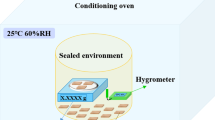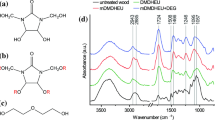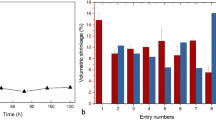Abstract
Furfurylation could have a significant influence on wood hygroscopicity. However, moisture sorption and its mechanism of furfurylated wood are not fully understood. The aim of this study was to clarify the effect of furfurylation on sorption behavior and the mechanism of moisture sorption for furfurylated wood. Water vapor sorption isotherms were derived from dynamic vapor sorption apparatus and analyzed employing Hailwood–Horrobin model. Simultaneously, fiber saturation point and accessible hydroxyl groups were determined by NMR cryoporometry and deuterium exchange method, respectively. Results indicated that compared with control sample, furfurylated samples with different weight gain percents (WPGs) exhibited a little difference in reduced equilibrium moisture content (EMCR) throughout RH range. Specifically, an increase below 30% RH and above 60% RH, and a reduction at 30–60% RH in EMCR of the furfurylated samples were showed, when compared with that of control sample. EMCR of 69% WPG displayed no distinguishable difference with that of 23% WPG over the whole RH range. Fiber saturation point increased with enhanced WPGs. However, accessible OH groups possessed a reduction with increased WPGs. The hygroscopic mechanism of furfurylated wood was associated with not only accessible OH groups but also other effects. This work could provide valuable guidance to control moisture-related properties of furfurylated wood.






Similar content being viewed by others

References
Li W, Chen Z, Yu H, Li J, Liu S (2020) Wood-derived carbon materials and light-emitting materials. Adv Mater. https://doi.org/10.1002/adma.202000596
Engelund ET, Thygesen LG, Svensson S, Hill CA (2013) A critical discussion of the physics of wood-water interactions. Wood Sci Technol 47:141–161. https://doi.org/10.1007/s00226-012-0514-7
Engelund ET, Svensson S (2011) Modelling time-dependent mechanical behaviour of softwood using deformation kinetics. Holzforschung 65:231–237. https://doi.org/10.1515/hf.2011.011
Ermeydan MA, Cabane E, Masic A, Koetz J, Burgert I (2012) Flavonoid insertion into cell walls improves wood properties. ACS Appl Mater Interfaces 4:5782–5789. https://doi.org/10.1021/am301266k
Xie Y, Krause A, Militz H, Mai C (2008) Weathering of uncoated and coated wood treated with methylated 1, 3-dimethylol-4, 5-dihydroxyethyleneurea (mDMDHEU). Holz als Roh-und Werkstoff 66:455. https://doi.org/10.1007/s00107-008-0270-4
Hill CA (2008) The reduction in the fibre saturation point of wood due to chemical modification using anhydride reagents: a reappraisal. Holzforschung 62:423–428. https://doi.org/10.1515/HF.2008.078
Himmel S, Mai C (2015) Effects of acetylation and formalization on the dynamic water vapor sorption behavior of wood. Holzforschung 69:633–643. https://doi.org/10.1515/hf-2014-0161
Rautkari L, Hill CA, Curling S, Jalaludin Z, Ormondroyd G (2013) What is the role of the accessibility of wood hydroxyl groups in controlling moisture content? J Mater Sci 48:6352–6356. https://doi.org/10.1007/s10853-013-7434-2
Wentzel M, Altgen M, Militz H (2018) Analyzing reversible changes in hygroscopicity of thermally modified eucalypt wood from open and closed reactor systems. Wood Sci Technol 52:889–907. https://doi.org/10.1007/s00226-018-1012-3
Hill CA, Ramsay J, Keating B, Laine K, Rautkari L, Hughes M, Constant BJJoMS, (2012) The water vapour sorption properties of thermally modified and densified wood. J Mater Sci 47:3191–3197. https://doi.org/10.1007/s10853-011-6154-8
Hosseinpourpia R, Adamopoulos S, Mai C (2016) Dynamic vapour sorption of wood and holocellulose modified with thermosetting resins. Wood Sci Technol 50:165–178. https://doi.org/10.1007/s00226-015-0765-1
Popescu C-M, Hill CA, Curling S, Ormondroyd G, Xie Y (2014) The water vapour sorption behaviour of acetylated birch wood: how acetylation affects the sorption isotherm and accessible hydroxyl content. J Mater Sci 49:2362–2371. https://doi.org/10.1007/s10853-013-7937-x
Papadopoulos A, Hill C (2003) The sorption of water vapour by anhydride modified softwood. Wood Sci Technol 37:221–231. https://doi.org/10.1007/s00226-003-0192-6
Altgen M, Hofmann T, Militz H (2016) Wood moisture content during the thermal modification process affects the improvement in hygroscopicity of Scots pine sapwood. Wood Sci Technol 50:1181–1195. https://doi.org/10.1007/s00226-016-0845-x
Biziks V, Andersons B, Sansonetti E, Andersone I, Militz H, Grinins J (2015) One-stage thermo-hydro treatment (THT) of hardwoods: an analysis of form stability after five soaking-drying cycles. Holzforschung 69:563–571. https://doi.org/10.1515/hf-2014-0083
Takayama M, Shida S, Matsumoto Y, Aoyagi T (2007) Determination of the accessible hydroxyl groups in heat-treated Styrax tonkinensis (Pierre) Craib ex Hartwich wood by hydrogen-deuterium exchange and 2H NMR spectroscopy. Holzforschung 61:488–491
Repellin V, Guyonnet R (2005) Evaluation of heat-treated wood swelling by differential scanning calorimetry in relation to chemical composition. Holzforschung 59:28–34. https://doi.org/10.1515/HF.2005.005
Borrega M, Kärenlampi PP (2010) Hygroscopicity of heat-treated Norway spruce (Picea abies) wood. Eur J Wood Wood Prod 68:233–235. https://doi.org/10.1007/s00107-009-0371-8
Altgen M, Daniela A, André K, Lauri R (2020) Effect of curing conditions on the water vapor sorption behavior of melamine formaldehyde resin and resin-modified wood. J Mater Sci 55:11253–11266. https://doi.org/10.1007/s10853-020-04814-0
Kong L, Guan H, Wang X (2018) In situ polymerization of furfuryl alcohol with ammonium dihydrogen phosphate in poplar wood for improved dimensional stability and flame retardancy. ACS Sustain Chem Eng 6:3349–3357. https://doi.org/10.1021/acssuschemeng.7b03518
Rosu L, Varganici C-D, Mustata F, Rusu T, Rosu D, Rosca I, Tudorachi N, Teacă C-A, (2018) Enhancing the thermal and fungal resistance of wood treated with natural and synthetic derived epoxy resins. ACS Sustain Chem Eng 6:5470–5478. https://doi.org/10.1021/acssuschemeng.8b00331
Lukowsky D (2002) Influence of the formaldehyde content of waterbased melamine formaldehyde resins on physical properties of Scots pine impregnated therewith. Holz als Roh-und Werkstoff 60:349–355. https://doi.org/10.1007/s00107-002-0324-y
Thygesen LG, Engelund ET, Hoffmeyer P (2010) Water sorption in wood and modified wood at high values of relative humidity. Part I: results for untreated, acetylated, and furfurylated Norway spruce. Holzforschung 64:315–323. https://doi.org/10.1515/hf.2010.044
Machado G, Leon S, Santos F, Lourega R, Dullius J, Mollmann ME, Eichler P (2016) Literature review on furfural production from lignocellulosic biomass. Nat Resour 7:115–129. https://doi.org/10.4236/nr.2016.73012
Yang T, Cao J, Ma E (2019) How does delignification influence the furfurylation of wood? Ind Crops Prod 135:91–98. https://doi.org/10.1016/j.indcrop.2019.04.019
Hill CA, Norton A, Newman G (2009) The water vapor sorption behavior of natural fibers. J Appl Polym Sci 112:1524–1537. https://doi.org/10.1002/app.29725
Xie Y, Hill CA, Xiao Z, Jalaludin Z, Militz H, Mai C (2010) Water vapor sorption kinetics of wood modified with glutaraldehyde. J Appl Polym Sci 117:1674–1682. https://doi.org/10.1002/app.32054
Beck G, Strohbusch S, Larnøy E, Militz H, Hill C (2017) Accessibility of hydroxyl groups in anhydride modified wood as measured by deuterium exchange and saponification. Holzforschung 72:17–23. https://doi.org/10.1515/hf-2017-0059
Shen X, Jiang P, Guo D, Li G, Chu F, Yang S (2021) Effect of furfurylation on hierarchical porous structure of poplar wood. Polymers 13:32. https://doi.org/10.3390/polym13010032
Telkki V-V, Yliniemi M, Jokisaari J (2013) Moisture in softwoods: fiber saturation point, hydroxyl site content, and the amount of micropores as determined from NMR relaxation time distributions. Holzforschung 67:291–300. https://doi.org/10.1515/hf-2012-0057
Crawshaw J, Cameron RJP (2000) A small angle X-ray scattering study of pore structure in Tencel® cellulose fibres and the effects of physical treatments. Polymers 41:4691–4698. https://doi.org/10.1016/S0032-3861(99)00502-9
Diniz JF, Gil M, Castro J (2004) Hornification-its origin and interpretation in wood pulps. Wood Sci Technol 37:489–494. https://doi.org/10.1007/s00226-003-0216-2
Malmquist L, Söderström O (1996) Sorption equilibrium in relation to the spatial distribution of molecules-Application to sorption of water by wood. Holzforschung 50:437–448. https://doi.org/10.1515/hfsg.1996.50.5.437
Barsberg ST, Thygesen LG (2017) A combined theoretical and Ft-Ir spectroscopy study of a hybrid poly (furfuryl alcohol)-lignin material: basic chemistry of a sustainable wood protection method. Chem Sel 2:10818–10827. https://doi.org/10.1002/slct.201702104
Nordstierna L, Lande S, Westin M, Karlsson O, Furo I (2008) Towards novel wood-based materials: chemical bonds between lignin-like model molecules and poly (furfuryl alcohol) studied by NMR. Holzforschung 62:709–713. https://doi.org/10.1515/HF.2008.110
Li W, Ren D, Zhang X, Wang H, Yu Y (2016) The furfurylation of wood: a nanomechanical study of modified wood cells. BioResources 11:3614–3625
Wang J, Mukhopadhyaya P, Morris PI (2014) Sorption and capillary condensation in wood and the moisture content of red pine. J Build Phys 37:327–347. https://doi.org/10.1177/1744259112453829
Engelund ET, Thygesen LG, Hoffmeyer P (2010) Water sorption in wood and modified wood at high values of relative humidity. Part 2: appendix. theoretical assessment of the amount of capillary water in wood microvoids. Holzforschung 64:325–330. https://doi.org/10.1515/hf.2010.061
Ehmcke G, Pilgård A, Koch G, Richter K (2017) Topochemical analyses of furfuryl alcohol-modified radiata pine (Pinus radiata) by UMSP, light microscopy and SEM. Holzforschung 71:821–831. https://doi.org/10.1515/hf-2016-0219
Lu Y, Pignatello J (2002) Demonstration of the “conditioning effect” in soil organic matter in support of a pore deformation mechanism for sorption hysteresis. Environ Sci Technol 36:4553–4561. https://doi.org/10.1021/es020554x
Jiang J, Cao J, Wang W, Xue J (2018) How silanization influences aggregation and moisture sorption behaviours of silanized silica: analysis of porosity and multilayer moisture adsorption. R Soc Open Sci 5:180206. https://doi.org/10.1098/rsos.180206
Yasuda R, Minato K, Norimoto M (1994) Chemical modification of wood by non-formaldehyde cross-linking reagents. Wood Sci Technol 28:209–218
Dieste A, Krause A, Militz H (2008) Modification of Fagus sylvatica (L.) with 1, 3-dimethylol-4, 5-dihydroxyethylene urea (DMDHEU): Part 1. estimation of heat adsorption by the isosteric method (Hailwood-Horrobin model) and by solution calorimetry. Holzforschung 62:577–583. https://doi.org/10.1515/HF.2008.101
Gao X, Zhuang S, Jin J, Cao P (2015) Bound water content and pore size distribution in swollen cell walls determined by NMR technology. BioResources 10:8208–8224
Phuong L, Takayama M, Shida S, Matsumoto Y, Aoyagi T (2007) Determination of the accessible hydroxyl groups in heat-treated Styrax tonkinensis (Pierre) Craib ex Hartwich wood by hydrogen-deuterium exchange and H NMR spectroscopy. Holzforschung 61:488–491. https://doi.org/10.1515/HF.2007.086
Acknowledgements
This work was financially supported by the National Key Research and Development Program of China (2017YFD0600202).
Author information
Authors and Affiliations
Corresponding authors
Ethics declarations
Conflict of interest
The authors declare that they have no conflicts of interest.
Additional information
Handling Editor: Stephen Eichhorn.
Publisher's Note
Springer Nature remains neutral with regard to jurisdictional claims in published maps and institutional affiliations.
Supplementary Information
Below is the link to the electronic supplementary material.
Rights and permissions
About this article
Cite this article
Shen, X., Guo, D., Jiang, P. et al. Water vapor sorption mechanism of furfurylated wood. J Mater Sci 56, 11324–11334 (2021). https://doi.org/10.1007/s10853-021-06041-7
Received:
Accepted:
Published:
Issue Date:
DOI: https://doi.org/10.1007/s10853-021-06041-7



